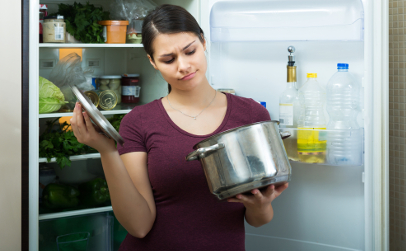Editor’s note: As the National Weather Service continued to predict rain for already flooded areas on Monday, the USDA updated its food safety advice to consumers who are able to return to their homes. The U.S. Department of Agriculture’s Food Safety and Inspection Service (FSIS) is issuing food safety recommendations for those who may be impacted flooding. FSIS recommends that consumers take the following steps to reduce the risk of foodborne illness during severe flooding events. 

- Raw or leftover cooked meat, poultry, fish, or seafood; soy meat substitutes
- Thawing meat or poultry
- Salads: Meat, tuna, shrimp, chicken, or egg salad
- Gravy, stuffing, broth
- Lunchmeats, hot dogs, bacon, sausage, dried beef
- Pizza – with any topping
- Canned hams labeled “Keep Refrigerated”
- Canned meats and fish, opened
- Casseroles, soups, stews
- Soft Cheeses: blue/bleu, Roquefort, Brie, Camembert, cottage, cream, Edam, Monterey
- Jack, ricotta, mozzarella, Muenster, Neufchatel, queso blanco, queso fresco
- Shredded Cheeses
- Low-fat Cheeses
- Milk, cream, sour cream, buttermilk, evaporated milk, yogurt, eggnog, soy milk
- Baby formula, opened
- Fresh eggs, hard-cooked in shell, egg dishes, egg products
- Custards and puddings, quiche
- Fresh fruits, cut
- Opened mayonnaise, tartar sauce, horseradish (discard if above 10°C for over 8 hours)
- Fish sauces, oyster sauce
- Opened creamy-based dressings
- Spaghetti sauce, opened jar
- Refrigerator biscuits, rolls, cookie dough
- Cooked pasta, rice, potatoes
- Pasta salads with mayonnaise or vinaigrette
- Fresh pasta
- Cheesecake
- Pastries, cream filled
- Pies – custard, cheese filled, or chiffon; quiche
- Vegetables: Greens, pre-cut, pre-washed, packaged
- Vegetables, cooked; tofu
- Vegetable juice, opened
- Baked potatoes
- Commercial garlic in oil
- Potato salad
- Casseroles, soups, stews
FSIS will provide relevant food safety information as a storm progresses from its Twitter feed @USDAFoodSafety and on Facebook at Facebook.com/FoodSafety.gov. FSIS’ YouTube video “Food Safety During Power Outages” has instructions for keeping frozen and refrigerated food safe. The publication “A Consumer’s Guide to Food Safety: Severe Storms and Hurricanes” can be downloaded and printed for reference during a power outage. FSIS also has an infographic covering what to do before, during and after a power outage. (To sign up for a free subscription to Food Safety News, click here.)
